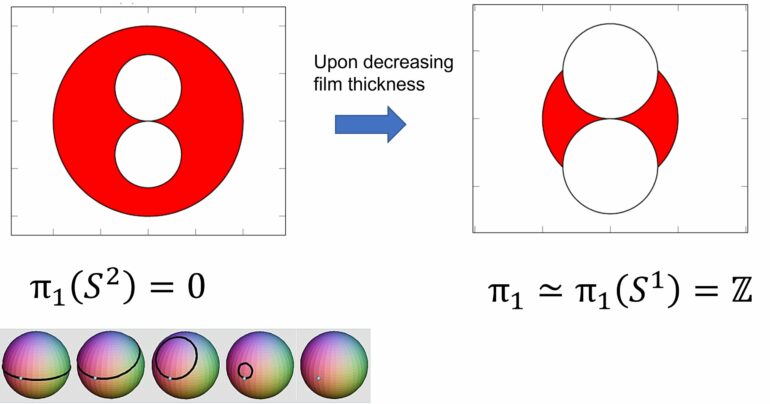Transistors are the basis for microchips and the whole electronic industry. The invention of transistors, by Bardeen and Brattain in 1947, awarded with a Nobel prize, is regarded as one of the most important discoveries of the 20th century.
Traditional transistors are based on modulating an electric current under an electric field, which is possible only using semiconductor materials. In semiconductors, there are fewer free charge carriers compared to metals, and the Fermi level (which is the thermodynamic work required to add one electron to the system) sits in an energy band gap, which implies that electrons are more difficult to excite.
By doping semiconductors, one can create a certain number of free carriers, e.g., in an empty band, which now can be excited to larger momenta and therefore can carry electric current through the material.
With semiconductors, a controlled flow of electrons from a source to a sink is possible under application of an electric field. Since the current-voltage characteristic of the material is strongly nonlinear, an electric signal can thus be amplified or suppressed, as in a p–n junction diode.
Why are transistors made of semiconductors and not, for example, metals? With metal conductors, it is not possible to make transistors due to the large number of free (extremely mobile) electrons, which completely screen the electric field inside the material.
In practice, as soon as you switch on an electric field across the conducting sample, all the electrons almost instantaneously move inside the sample and redistribute internally such that their new spatial distribution creates an electric field that exactly cancels the externally applied electric field.
This phenomenon thus prevents the possibility of controlling the flow of electricity (microscopically, the flow of free electrons) when an external electric field is switched on across the conductor.
Recently, metallic superconductors only a few nanometers thick have been used experimentally to realize a new electric field effect as a viable route toward metallic transistors. Superconducting materials are metals, which, if they are cooled down below a certain critical temperature, can support the flow of electrons with no resistance. In other words, they are ideal conductors where electricity can be carried through with no dissipation or resistance.
The reason for this seemingly magic behavior resides in the formation of electron pairs kept together by a “glue” provided by lattice thermal motions. These pairs obey quantum statistics (Bose-Einstein statistics), which allows for a huge number of particles (glued electron pairs, in this case) to occupy the lowest energy state or ground state.
The ground state then forms a coherent quantum wavefunction which is immune from scattering processes that generate resistivity, and thus, the electrons can flow freely through the material and carry electricity with no energy dissipation.
Working with these superconducting metal devices, an experimental team led by Francesco Giazotto at the Italian Centro Nazionale delle Ricerche (CNR) observed that an external electric field of sufficient amplitude can suppress the electric current. This phenomenon thus enables the use of the superconducting thin film as a diode, since now, we can control the electric current through the metal by tuning the external electric field.
Even though the experiments were done using very standard conventional materials (e.g., aluminum), this effect could not be explained by the standard theory of superconductivity (which was developed by the same physicist, John Bardeen, who co-discovered the transistor and for which he was awarded a second Nobel prize in physics, a quite exceptional case in history).
This theory, known as the Bardeen-Cooper-Schrieffer or BCS theory, explains that the lattice thermal motions (phonons) provide the glue that forms the electron pairs by overwhelming the repulsive Coulomb interaction between the two electrons.
In recent years, I have been working on a theory that generalizes the BCS theory to very thin metallic films, with a thickness of just a few nanometers or even lower than one nanometer.
In this new theory, I have mathematically implemented the principle that quantum particles such as electrons are also associated with a wavelength. If this wavelength exceeds the size of the thin film, the corresponding electron cannot propagate through the sample.
By working out the math, together with my student Riccardo Travaglino, I figured out that the corresponding distribution of electron states in the space of available momenta (where the momentum of a quantum particle is proportional to the inverse of its wavelength) gets modified by the geometric confinement.
In particular, we found that the so-called Fermi sphere, which describes the occupied momenta of free electron states in metals, acquires two symmetric spherical “hole pockets” of forbidden states (see figure above). Using this finding, we were able to calculate the critical temperature at which the metal becomes superconducting, in excellent agreement with experimental data.
A few months later, in the spring of 2023, I met Professor Vladimir Fomin from the Leibniz Institute in Dresden, and I illustrated our findings for him. He immediately pointed out the potential relevance of our theory for the experimental “superconducting metallic diode” discovered by Giazotto and co-workers.
During the summer of 2023, with Professor Fomin, we thus started a collaboration aimed at implementing the confinement theory to describe a superconducting thin film under an external electric field.
For this new theory, we had to take into account the fact that the “glue” provided by the phonons is also affected by the concentration of free electrons, and so is their Coulomb repulsion. These quantities, in turn, are both strongly affected by the confinement of the thin film.
The new theory, accounting for these crucial aspects, shows for the first time that the suitably modified microscopic Bardeen-Cooper-Schrieffer theory accounting for confinement can predict the electric-field-induced suppression of superconducting electric current due to quantum wave confinement effects in ultra-thin films.
In practice, due to the confinement, there are hole pockets inside the Fermi sea that lead to an increased density of states at the Fermi surface. In turn, this effect enhances the Coulomb repulsion between electrons to the extent that an electric field can easily break up the electron pairs kept together by the phonon “glue.” The theory thus explains that this effect becomes larger upon decreasing the film thickness, in agreement with experimental observations.
Thanks to this new theory, a whole range of quantum gate materials can be developed and optimized in future applications. Furthermore, the confinement theory predicts a new topological transition upon further reducing the film thickness from a trivial topology of the Fermi surface to a non-trivial topology associated with a change in the electronic properties.
Our research is published in the journal Physical Review B.
This story is part of Science X Dialog, where researchers can report findings from their published research articles. Visit this page for information about Science X Dialog and how to participate.
More information:
Alessio Zaccone et al, Theory of superconductivity in thin films under an external electric field, Physical Review B (2024). DOI: 10.1103/PhysRevB.109.144520. On arXiv: DOI: 10.48550/arxiv.2312.13059
Alessio Zaccone is an Italian physicist working in various areas of condensed matter theory, ranging from soft matter to the theory of quantum systems. He is a full professor at the University of Milan, after having taught at the Technical University Munich and at the University of Cambridge. He is the recipient of an ERC Consolidator grant and the author of a monograph titled “Theory of Disordered Solids,” published by Springer in 2023.
Citation:
Unveiling the microscopic mechanism of superconducting metallic transistors (2024, May 28)



